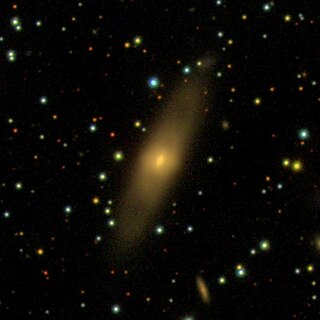
NGC 1250 is an edge-on lenticular galaxy located about 275 million light-years away in the constellation Perseus. It was discovered by astronomer Lewis Swift on Oct 21, 1886. NGC 1250 is a member of the Perseus Cluster.
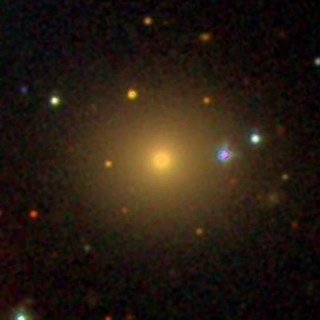
NGC 1259 is a lenticular galaxy located about 243 million light-years away in the constellation Perseus. The galaxy was discovered by astronomer Guillaume Bigourdan on October 21, 1884 and is a member of the Perseus Cluster.

NGC 1264 is a low-surface-brightness barred spiral galaxy located about 145 million light-years away in the constellation Perseus. The galaxy was discovered by astronomer Guillaume Bigourdan on October 19, 1884. NGC 1264 is a member of the Perseus Cluster.

NGC 1267 is an elliptical galaxy located about 220 million light-years away in the constellation Perseus. NGC 1267 was discovered by astronomer Heinrich d'Arrest on February 14, 1863. NGC 1267 is a member of the Perseus Cluster and is possibly interacting with the spiral galaxy NGC 1268.

NGC 1268 is a spiral galaxy located about 140 million light-years away in the constellation Perseus. It was discovered by astronomer Heinrich d'Arrest on February 14, 1863. NGC 1268 is a member of the Perseus Cluster and appears to show signs of distortion in the form of bridges. These features may be the result of a strong interaction with NGC 1267.

NGC 1273 is a lenticular galaxy located about 245 million light-years away in the constellation Perseus. It was discovered by astronomer Heinrich d'Arrest on February 14, 1863 and is a member of the Perseus Cluster.
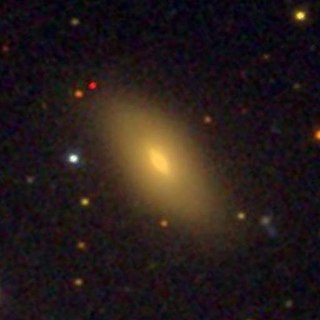
NGC 1274 is a compact elliptical galaxy located about 280 million light-years away in the constellation Perseus. NGC 1274 was discovered by astronomer Lawrence Parsons on December 4, 1875. It is a member of the Perseus Cluster.
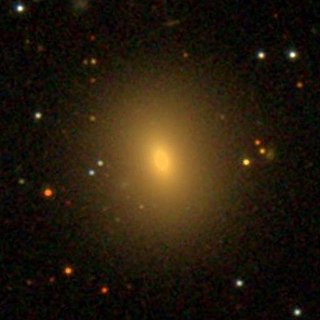
NGC 1270 is an elliptical galaxy located about 250 million light-years away in the constellation Perseus. It was discovered by astronomer Heinrich d'Arrest on February 14, 1863. NGC 1270 is a member of the Perseus Cluster and has an estimated age of about 11 billion years. However, Greene et al. puts the age of NGC 1270 at about 15.0 ± 0.50 Gy.
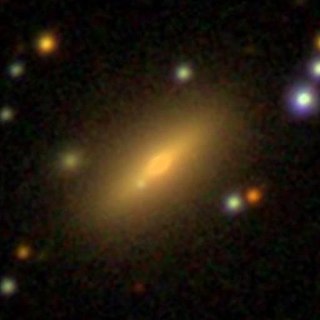
NGC 1271 is a compact elliptical or lenticular galaxy located about 250 million light-years away in the constellation Perseus. The galaxy was discovered by astronomer Guillaume Bigourdan on November 14, 1884. NGC 1271 is a member of the Perseus Cluster and has a nuclear dust disk in its center. It also has an edge-on, intermediate-scale disk and has a central bulge. Like NGC 1277, NGC 1271 is a candidate "relic galaxy".
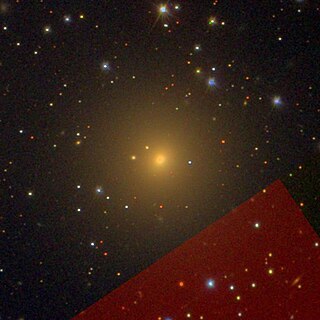
NGC 1272 is a massive elliptical galaxy located about 230 million light-years away in the constellation Perseus. It was discovered by astronomer Heinrich d'Arrest on February 14, 1863. NGC 1272 has an active nucleus and is the second brightest member of the Perseus Cluster after NGC 1275.
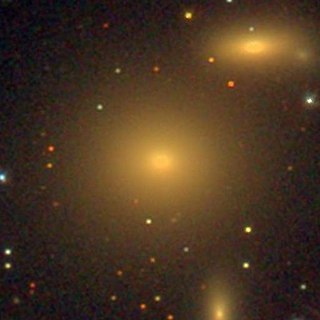
NGC 1278 is an elliptical galaxy located about 230 million light-years away in the constellation Perseus. NGC 1278 was discovered by astronomer Heinrich d'Arrest on February 14, 1863. It was then rediscovered by astronomer Guillaume Bigourdan on October 22, 1884 and was later listed as IC 1907. NGC 1278 is a member of the Perseus Cluster and is a low-luminosity AGN (LLAGN).

NGC 1281 is a compact elliptical galaxy located about 200 million light-years away in the constellation Perseus. NGC 1281 was discovered by astronomer John Dreyer on December 12, 1876. It is a member of the Perseus Cluster.

NGC 1282 is an elliptical galaxy located about 230 million light-years away in the constellation Perseus. It was discovered by astronomer Guillaume Bigourdan on October 23, 1884. NGC 1282 is a member of the Perseus Cluster.

NGC 1283 is an elliptical galaxy located about 250 million light-years away in the constellation Perseus. The galaxy was discovered by astronomer Guillaume Bigourdan on October 23, 1884 and is a member of the Perseus Cluster. It also contains an active galactic nucleus.

NGC 1293 is an elliptical galaxy located about 215 million light-years away in the constellation Perseus. It was discovered by astronomer William Herschel on October 17, 1786. NGC 1293 is a member of the Perseus Cluster.

NGC 1294 is a lenticular galaxy located about 285 million light-years away in the constellation Perseus. The galaxy was discovered by astronomer William Herschel on October 17, 1786 and is a member of the Perseus Cluster.

NGC 1334 is a spiral galaxy located about 185 million light-years away in the constellation Perseus. It was discovered by astronomer Heinrich d'Arrest on February 14, 1863. NGC 1334 is a member of the Perseus Cluster and is a starburst galaxy. It also appears to have a complex distorted structure.

NGC 3867 is a spiral galaxy located about 350 million light-years away in the constellation Leo. It was discovered by astronomer Édouard Stephan on March 23, 1884 and is a member of the Leo Cluster.

NGC 3873 is an elliptical galaxy located about 300 million light-years away in the constellation Leo. The galaxy was discovered by astronomer Heinrich d'Arrest on May 8, 1864. NGC 3873 is a member of the Leo Cluster.

NGC 4212 is a flocculent spiral galaxy with LINER activity located about 53 million light-years away in the constellation Coma Berenices. The galaxy was discovered by astronomer William Herschel on April 8, 1784, and was listed in the NGC catalog as NGC 4208. He then observed the same galaxy and listed it as NGC 4212. Astronomer John Louis Emil Dreyer later concluded that NGC 4208 was identical to NGC 4212. NGC 4212 is a member of the Virgo Cluster.




















